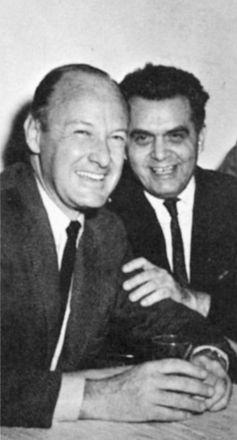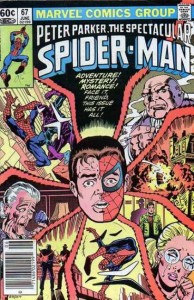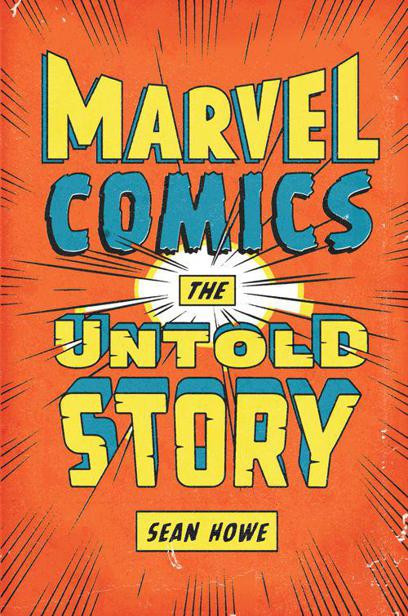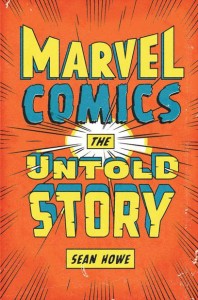I recently had the pleasure of reading Marvel Comics: The Untold Story, and just to clarify the title, the review isn’t sad because the book was poorly written, it’s sad because it reveals the inner workings of a company known for making “funnybooks”, and it ain’t too funny at all.
Marvel Comics: The Untold Story
Marvel Comics: The Untold Story is written and painstakingly researched by author Sean Howe, who takes us from the early 1940’s beginnings all the way through to the current day of Marvel’s movie juggernaut machine.
Although the end result of the work and creativity of all involved is a brightly colored, (hopefully) entertaining story, the fact remains that Marvel Comics is a business looking to make money, and this book focuses heavily on the business decisions that shaped the stories (and careers) of some of the industry’s greatest creators.
By this point, I can’t say I was naive to the facts of life, and the bottom-line of any business, but I do have to say that reading this book was sometimes a bit depressing. I only found time to read this late at night, and I always made sure I had a back-up comedy or something light-hearted to read or watch before I went to sleep. A couple of nights laying awake thinking about how many of the artists were used up and thrown away was more than enough for me.
Many of you who have been to this site before know that I’m an artist, so I tend to side with the creatives vs. management, but sometimes in reality the situations aren’t as clear-cut as I’d like.
Now, on with the details…
Stan and Jack

Stan Lee
Stan Lee may not exactly be a house-hold name, but if not, he’s pretty damn close.
Hailed as the creator of all our favorite heroes such as Spider-Man, The Avengers, The Hulk, The X-Men, and especially the much reviled (by me, anyway) Fantastic Four – among many others. Stan is seen by many as the embodiment of Marvel Comics, even though he hadn’t officially worked there in many years.
One thing you couldn’t deny, the guy had flair. The book describes his humble origins, and his move up the food chain at Marvel until he became it’s voice.
As a kid, Stan was the guy who convinced me that all they did at Marvel all day long was sit around and have fun creating super-hero tales. He coined the “Merry Marvel Bullpen” and was always giving out energetic, phonetic nicknames to his writers and artist, such as “Rascally” Roy Thomas or “Jolly” Jack Kirby. This extended to the books, themselves. Stan didn’t want the books to have plain old boring titles like “Superman” or “Batman”. He always had to have some kind of adjective in there to punch it up.
So Iron-Man couldn’t simply be Iron-Man, he had to be “The Invincible Iron-Man”, and of course the Hulk couldn’t just be the Hulk, he had to be “The Incredible Hulk”. Stan was great with snappy dialogue, and people loved it.
The book details how he went from creator, to overseer, to executive, to movie pitchman, to essentially figurehead of the company. It also describes the flipside of the coin.
Jack Kirby
Where Stan was the writer, Jack “King” Kirby was the artist who created the visuals for most of those before mentioned heroes.
Although Spider-Man is a bit of an exception/mystery. Kirby claims to have drawn the first Spider-Man. The story out there seems to be that Jack made Spider-Man look “too heroic”, and so legendary artist Steve Ditko was brought in to do the art chores. This may or may not be true, though…
Anyway, Jack’s story is a pretty depressing tale, and is similar to the plight of most creatives who started in that era. His artwork was created as a “work-for-hire”, meaning he had no control over it or rights to it after he drew it, and it was owned by Marvel.
He was paid a flat rate for his work, and did not share in any of the sales money that came in. This was the standard deal back then, and remains the deal for many artists today -although at least there are other options now.
Jack bounced around from Marvel to DC, creating many of their most popular, iconic characters, and yet struggled with money problems for pretty much his entire life until his death in 1994. Again, this was a similar tale to most other artist in the field.
The thing about Jack, is his art always had a lot of action, he knew how to tell a story. As a kid, I didn’t appreciate his art because the popular styles had changed by the late 70’s. Only when I got to college and was really trying to communicate a story with my art did I see what a gift Jack Kirby really had. It’s hard to draw those panels and not have the characters appear stiff and lifeless. He really put the motion and life into those comics.
Who created who…and what?
Years later, Stan and Jack could be seen publicly feuding over who actually created and wrote the stories.
The “Marvel Style” of creating comics was a bit fast and loose.
Essentially, the artist would get the general plot of the comic:
The Fantastic Four fight Dr. Doom in his castle, make sure Sue is captured at the end.
They would have to make sure it filled up all the pages, and they would have to be careful to leave enough space for the words -even though they didn’t know what those words would be. Also, remember there were no computer layout programs, they were writing this out by hand and using white-out and cut and paste techniques to clean up mistakes.
So after the story was drawn out by Jack, Stan would come along and fill in the words behind him. This process allowed them to work very quickly, but led to drama later.
Jack Kirby would claim later that he really “wrote” the comics, too. He said “I did everything but fill in the balloons” (paraphrased). Stan would deny this, but he would also end up in public conflict with Steve Ditko over Spider-Man in later years.
What’s Right? What’s Fair? What’s Legal?
Creator rights have been a huge issue in comics for the last 30 years, although only with the creation of Image Comics about 20 years ago did the issue really gain the spotlight among all comic readers.
Jack Kirby was a poster-child of the industry’s unfair treatment of it’s artists. He had created the visual look of many classic characters, plus created artwork that continued to be reprinted and sold -for which he received nothing other than a flat fee.
Unfortunately, that is the deal that was on the table back then for many artists. I think it sucks, and demonstrates a shameful abuse of talent by the management. What they did was certainly legal, but that doesn’t mean it was right.
Take Jerry Siegel, one of the co-creators of Superman. In the late 60’s, the only job he could get was working at Marvel as a proofreader. The legal actions taken against DC by Siegel and Superman co-creator Joe Shuster are an embarrassing eyesore for the comics industry. The veneer of brightly-colored super-heroics was ripped away and the brutal reality of just another bottom-line business was revealed.
Although we’re talking about DC now, consider how much money Superman has made over the years, and now with another big-budget blockbuster due this summer. Should Siegel and Shuster really have died in near-poverty?
Were Siegel and Shuster entitled to any of the proceeds following their initial creation of the work for hire? If Jack Kirby had been alive, would he be entitled to Avengers money? Legally, the answers are simple, even ethically for the time, but morally?
The book doesn’t try to answer these questions, but simply presents what happened. As I’ve mentioned, it’s a familiar, depressing, and too oft-repeated tale.
Marvel Movie Madness
Moving on, one of the big takeaways from this book is that Stan Lee, whatever you chose to think of him, was way ahead of his time.
He had been trying to get these Marvel characters onto the big screen for about half a century before it finally happened. Now that’s dedication!
Stan, and others at Marvel, could see the potential for capitalizing on this vast stable of characters, even though Hollywood couldn’t quite see it…yet.
Sure, it’s easy for everyone to see how bankable they are now, but before the turn of the century, super-heroes were a hard sell to the general public. I think it’s obvious that technology had to catch up to the super-hero sci-fi in order to keep it from looking completely stupid, but Marvel also had to ride out a cultural shift in the attitude towards comics. Even today, many see comics as “just for kids”, despite many top-notch artist and writers from other genres, not to mention popular tv shows “validating” them.
That’s not all, folks..!

There’s much, much more to this book. The daily lives of the artists, writers, management and even the publishers is described in careful detail.
Even more interesting that this, is the necessary changes the comics, and the business of comics, underwent because of cultural and generational shifts in thoughts and attitudes.
Some creators were button-down company men, while others were counter-culture types, indulging in the latest psychotropic drugs of the era to come up with stories and influence their art.
Layoffs, firings, betrayals, corporate buyouts, plus Adventure, Mystery, Romance…face it, friends…this issue has it all!
The Wrap Up -pick this up!
So even though there are some sad points to this book, it is extremely fascinating and eye-opening. If you have any interest in comics you’d do well to check this out, you won’t be able to stop reading. Yes, it helps that I actually remember most of the issues and stories they mention, but even if you don’t, the behind the scenes look is a good enough story itself.
After reading it, I have to admit I’m somewhat glad I never really made it into the industry. Some of these guys came in wide-eyed and starstruck, but left defeated and burned out. I’d hate to end up like that.
Still, I’m grateful to the creators, the management and the publishers for putting this stuff out there. I wouldn’t be who I am today without being inspired by the many awesome tales of super-heroic men, monsters and Gods put out over the last 3/4 century by Marvel Comics.
I’m outta here for now, see you guys next time!
The Amazon links to the book are my affiliate links, and I’ll receive some compensation from Amazon if you choose to buy from those links. If you don’t have a Kindle, or don’t want to buy the hardcover from Amazon, you can visit the author Sean Howe’s site to purchase for Nook/iBookstore, or hardcover from there (I receive no compensation if you buy from the author’s link). You can also read some excerpts if you go to the author’s site.



In a weird way, I can relate to this because of all the articles I’ve written that someone else has gotten credit for or earned money off that I can find & identify but can’t tell anyone I wrote. Yes, I knew and know what I’m getting into, but when you know that others are banking off it… hey, it’s why my deals are better now.
Still, I didn’t expect Marvel Comics to come off any cleaner than any other industry in the long run. Stan Lee is still the man after all these years, but it’s intriguing that one never heard of most of the other people you mention. This certainly wasn’t like the people who drew Warner Brothers cartoons, that’s for sure.
Hey Mitch, yeah it only “seems” extra awful because Marvel pumps out colorful, heroic characters who help people, but then you see it for what it is – a business trying to make money like any other business.
And yes, the artists mostly got run over in the deal, although I don’t fault Stan for that -he was just good at promoting himself, and the book shows he tried to help folks when he could. Despite his name brand as the face of Marvel, he just didn’t have the power to call the shots.
Interesting facts, I won’t call it sad but sometimes, the truth can be shocking… and actually I can picture myself that your article has ruined some myths in the fans…
Hi Maya, I agree that when you look underneath the veneer you’ve been shown, the reality can definitely be a surprise.
This book will definitely ruin some of the more naive misconceptions, that’s for sure. Thanks for reading!
I read comics for years, about the time I started reading I was into comics and to this day still have many of them! Wow I might be rich!! Well maybe, if I were Sheldon and his cronies and took very good care of them, but for me they were there to read and that I did, many times over. It is sad but as I was told years ago, always get it in writing. Back in their day it was a handshake deal, these days everything should be in writing or yes, you could lose out big time on what should be rightfully yours.
Loved the post, really brought back some great memories so thank you for that! Not sure I want to read the book as it will probably kill the thrill I got reading those comics so many years ago, but might also learn something in the end. Thanks again!
Hey Ron, very true – those were the types of deals that were normal for that day and age. It sucks but we know better now.
I’m glad I was able to bring back some good memories, and yes I’d avoid the book if you’d rather hold on to all those good feelings :)
Thanks for commenting!
You kinda want Marvel to be more than just another company and it’s abit of a bummer to see that they are a company that make business decisions instead of creative ones. But it is understandable that they would want the company to grow. That way they can publish more and expose their comics to more people aswell.
” Marvel comics – untold story “review has really given new dimension of the author Sean Howe, who was un claimed emperor of comic books in past century.
I really miss the old Marvel. Buying comics and collecting until there’s no more space in your room! Truth can be shocking but I’m happy to see that there’s book that shows/tells what’s behind the Marvel scenes.
No doubt, the truth can be a bit jarring, especially when the public face of the company is so friendly and affable. I miss the days of misspent youth, too -collecting comics and not another care in the world…good times!
Thanks for reading and all the best!